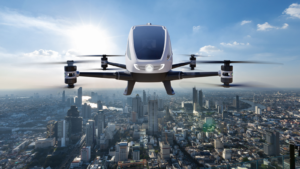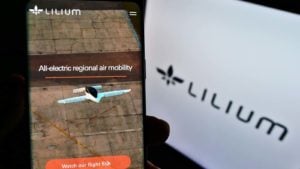In 1999, General Motors (NYSE:GM) finally pulled the plug on its first mass-produced electric vehicle (EV) of the modern era, the EV1. Battery technologies at the time limited the standard EV1 to a 55-mile range — not enough to cross Los Angeles County on a traffic-free day. An extended 105-mile-range version had its own problems, such as needing a full discharge to get fully charged again.
Today, a similar technological problem plagues electric vertical take-off and landing (eVTOL) aircraft — the “flying cars” that run on electrical power. The lithium-ion batteries that power these devices are cumbersome; Joby Aviation’s (NYSE:JOBY) power packs for its S4 flagship could weigh up to 2,200 lbs. One analysis by Professor Venkat Viswanathan at Carnegie Mellon University estimates that leaves just 1,600 lbs. for the airframe, avionics and everything else on board.
Autonomous technologies also lag. Self-driving cars routinely run into issues, and minor fender-benders on the road will quickly turn into major disasters in the sky. There’s a reason why Joby’s flagship model will require a pilot’s license to operate. That will leave most eVTOLs as toys for the wealthiest Americans who can afford to hire pilots.
Most worryingly, quant systems are now predicting a slowdown in stock markets, a negative sign for startups that burn cash. Since July, my MarketMasterAI system has been pivoting toward blue-chip stocks and selling out of biotech and other startups.
That means it’s time to get out of flying car stocks. These capital-intensive firms require enormous amounts of money for research and production. And with American investors tightening their wallets, these five flying car stocks look set to decline over the next several months.
Joby Aviation (JOBY)

Joby Aviation is the most promising American eVTOL company to date. The firm was one of the earliest movers and has already performed over 1,000 test flights on its current designs. According to its management, the startup could begin commercial passenger service as early as 2025. The firm has also already delivered its first air taxi to the U.S. Air Force for testing.
But being the first mover hasn’t guaranteed Joby’s success. Since going public in 2020, the company has lost 40% of its market capitalization while missing key milestones. Its current 2025 launch date target was initially scheduled for 2023. A 2024 launch date for its Uber-like “air taxi” service looks impossible to achieve.
The company faces a further uphill challenge with Federal Aviation Administration (FAA) approvals, a fact that Kerrisdale Capital’s lengthy 41-page report on the company highlights in excruciating detail. Joby has only received approvals for its paperwork, not for real-world testing or verification.
The financial clock is also ticking. Unlike many other research outfits, Joby Aviation generates no revenues from grants or partnerships, choosing instead to fund its entire research budget internally. That presents a mathematical problem. In the most recent quarter, the eVTOL startup had only $1.2 billion in cash remaining, roughly enough for 3.5 years of research and development (R&D) at current cash-burn rates.
But Joby’s $1.3 million-per-aircraft costs mean the cost of goods for its 1,000-fleet target alone comes to $1.3 billion. The company’s sagging stock price and rising interest rates will make it increasingly difficult to top off reserves. For every 10% decline in the company’s market capitalization, shareholders are diluted by an additional 11.1% for each capital raise thanks to exponential math.
That makes Joby’s $4.4 billion market capitalization a risky gamble at best. Though the company has a head start in the eVTOL race, being the first mover isn’t helpful if you run out of cash first.
Archer Aviation (ACHR)

Archer Aviation (NYSE:ACHR) has seen similar delays for its eVTOL projects. Its initial promise of reaching cash-flow breakeven by 2025 has been replaced by a less ambitious goal of commencing operations by that year.
Short-seller Grizzly Research finds a significant lack of progress on Archer’s flight testing and production facilities. Neighboring businesses and former employees reported seeing “only a handful of flights conducted solely for special events,” and on-site visits showed “scant signs of anything approaching production readiness.” The company is now facing multiple lawsuits alleging shareholder fraud.
California-based eVTOL startup also has an even worse cash-flow problem than Joby. The company has only $408 million of cash left on hand, which means it could run out of money within 1.5 years without additional capital raises. Moving into production will require north of $1 billion if the firm doesn’t contract out manufacturing.
That poses a problem for Archer, a cash-hungry company that will need several more fundraising rounds to reach commercial viability. Its relatively low $1.4 billion valuation means that every year of cash burn will dilute current shareholders by almost 20%. And recent allegations of wrongdoing will likely make partner Stellantis (NYSE:STLA) think twice about topping off funds.
Macroeconomic headwinds further add to the problem. Since January, MarketMasterAI — my stockpicking AI system — has been selling off stocks of highly indebted meme stocks, including Rite Aid (NYSE:RAD) and the former Bed, Bath & Beyond. That suggests a bear market ahead. Investors take note: markets have traditionally punished stocks like Archer Aviation in moments like these.
EHang (EH)

Trading in shares EHang (NYSE:EH) surged 40% on Friday morning after the Guangzhou-based eVTOL firm announced it had gained a type certificate from China’s aviation regulators for its 216-S model. That makes it the most advanced firm, based on gaining approvals from a major regulator.
The company has a better cash profile than Archer or Joby. EHang consumes only $20 million in cash annually and generates significant revenues from product sales. In 2021, the company sold 30 passenger-grade autonomous aviation vehicles (AAVs). Its backlog allegedly grew to over 1,000 units the following year, and the firm already has several EHang 216 models used in aerial sightseeing across Chinese tourist destinations.
Nevertheless, MarketMaster awards EHang an “F” grade for its lack of profitability, declining analyst estimates, and a share price that appears ready for a reversal. Since January, EHang’s earnings per share (EPS) predictions have been revised down from -35 cents to -68 cents, a 94% decline. 2024 figures have been cut to -45 cents. As for prices, Friday’s initial 40% surge was later met with a 20% pullback — a sign that investors are meeting positive news events with skepticism.
EHang also faces a broader scaling problem. During the most recent quarter, EHang delivered just five units, down from 11 in the previous quarter. This suggests that EHang either lacks the purchase orders for its thousand-unit backlog or is struggling to raise enough cash to fund production.
The first case is the most worrying. Some electric vehicle startups have long touted significant preorder figures, only for customers to walk away. EHang’s balance sheet only shows $3 million in contract liabilities, which amounts to only 10 eVTOL aircraft.
The second case could haunt investors. Producing eVTOL aircraft is expensive, and EHang’s $23 million private capital raise in July could be just the start of more significant dilution to come.
In either case, AI algorithms are warning of an upcoming share price reversal. It is best to wait for a better entry point to emerge.
Lilium (LILM)

Lilium (NASDAQ:LILM) is a German-based eVTOL company that was founded in 2015. Its proof-of-concept model was launched in 2017, and the company soon started courting significant deals.
However, Lilium would soon run into controversy. In 2020, the German magazine Aerokurier published a report that suggested Lilium’s aircraft could only fly for two minutes at a time. A separate short-seller report in 2022 voiced similar concerns about Lilium’s flying range.
The eVTOL startup is also beginning to face the realities of accounting. During the second quarter, Lilium had to raise an additional $292 million from private placements and other sources. According to estimates from Thomson Reuters, Lilium’s outstanding shares have now increased 80% since the start of the year, diluting existing shareholders by almost half. Meanwhile, the German firm still only has enough cash for 12 more months of operations at estimated spending rates.
That means Lilium’s ability to hit development and certification milestones could be all for nothing. Shares of the struggling eVTOL firm trade at just 66 cents on the Nasdaq exchange, pricing the company at $343 million. Subtracting cash puts Lilium’s enterprise value at near zero, which means future capital raises will likely be even more dilutive to current shareholders.
The company scores an “F” in MarketMasterAI, and history tells us to expect a 5% share decline over the next six months.
Of course, short-selling Lilium is out of the question. Rock-bottom valuations mean that shares will spike on any good news, and the high concentration of private investors makes short squeezes more likely. It’s why MarketMasterAI gives the firm just a 5% expected decline: a 90% chance of hitting zero can be offset by a 10% chance of the stock rising 10x.
Still, history tells us to avoid moonshot stocks during recessionary periods. And with the U.S. seemingly close to one, it’s likely best to cut losses and wait for market fears to settle.
Vertical Aerospace (EVTL)

Vertical Aerospace (NYSE:EVTL) is the final eVTOL startup to receive an “F” grade by MarketMasterAI.
The microcap company was founded in 2016 in the U.K., and has since partnered with Rolls-Royce (OTCMKTS:RYCEY) and Honeywell (NASDAQ:HON) to co-develop its powertrain and flight control systems. Its proprietary battery system uses cylindrical cells to provide higher power density than many rivals.
The company has attracted significant talent, including senior engineers from Boeing (NYSE:BA) and others. The population distribution of the United Kingdom makes eVTOLs particularly attractive, since roughly half of its population live within 100 miles of London. Vertical Aerospace’s flagship VX4 could theoretically reach that distance on a single charge.
Still, Vertical Aerospace faces the same financial issues as its rivals. Over the past 12 months, the company has consumed $114 million in cash, a rate that would deplete its remaining liquidity by the end of 2024.
The U.K. firm has also failed to generate meaningful revenues or pre-order liabilities despite allegedly having over 1,400 pre-ordered aircraft. That suggests its $5 billion-plus of pre-orders have not been backed up by any significant payments or commitments. Indeed, the company carefully notes in its official filings that all pre-orders are conditional and may be terminated at any time.
From a financial perspective, this suggests that Vertical Aerospace will have to raise much more capital in the coming quarters, diluting shareholders and lowering its stock price. Its current market capitalization of $260 million means every year of cash burn will dilute shareholders by another 40%.
Though the U.K. startup may eventually succeed, the odds are stacked against it. The best hope is that Vertical Aerospace’s management can sell themselves to a larger rival before cash eventually runs out.
Are eVTOLs 20 Years Too Early?
In 2020, I warned investors about Hyliion (NYSE:HYLN), an electric powertrain company that promised a “breakthrough” in electrifying Class 8 tricks: “Hyliion represents a new class of investments that were once only available to venture capitalists (VCs): zero-profit, high-potential moonshots.”
Essentially, Hyliion was pursuing a risky strategy that could either shoot the moon or (most likely) crash to earth. Its shares have since done the latter, following the trajectory of GM’s EV1 electric vehicle.
The same issues are now showing up with pure-play eVTOL stocks. These moonshot companies could eventually become the next electric vehicles. Artificial intelligence is rapidly improving, and it’s not hard to see a future where self-flown eVTOLs are as affordable and reliable as passenger cars today.
The ultralight Jetson One flyer is already available for just $98,000 and doesn’t require a pilot’s license. (You just need to weigh less than 210 pounds and preferably have good health insurance.) Further improvements in battery technologies and materials sciences will reduce the weight and costs of future eVTOLs.
The financial reality, however, is that most of these startups have raised too little money to get past their certification stages… let alone begin production. It’s why many Chinese electric car companies outsource their research and production to focus only on marketing and service. And unless these five eVTOL companies are willing to perform similar feats, they will eventually go bankrupt or get bought out at a discount by larger firms like Brazil’s Embraer (NYSE:ERJ), which has its own eVTOL ambitions. Best to sell these five pure-play stocks and wait for better times.
As of this writing, Tom Yeung did not hold (either directly or indirectly) any positions in the securities mentioned in this article. The opinions expressed in this article are those of the writer, subject to the InvestorPlace.com Publishing Guidelines.
